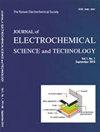金属表面碳颗粒掺杂聚合物层作为耐化学和机械性能的热电子电化学复合电极
IF 3
4区 工程技术
Q3 ELECTROCHEMISTRY
Journal of electrochemical science and technology
Pub Date : 2021-10-27
DOI:10.33961/jecst.2021.00640
引用次数: 0
摘要
本文提出了一种在可重复使用的基底上制备耐化学和机械腐蚀的热电子发射复合电极的简单而廉价的方法。在本研究中,通过在聚合物尼龙6,6中掺杂几种不同品牌的碳颗粒(石墨、炭黑),并在金属基底上涂覆具有不同碳聚合物质量分数的上述复合油墨层,制备了热电子发射复合电极。这些复合层中的最佳质量分数允许制备复合电极,该复合电极可以将热电子注入电解质水溶液中并清楚地产生热电子诱导的电化学发光(HECL)。使用芳香族铽(III)螯合物作为探针,已知其不基于传统电化学而被激发,而是在存在水合电子的情况下以及在将热电子注入水溶液期间被有效地电激发。因此,通过HECL监测在复合电极表面附近的热的、预水合的或水合的电子的存在。研究表明,极端pH条件不会损坏现有的复合电极。因此,这些低成本、简化和坚固的复合电极表明,它们可以用于HECL生物亲和性测定和热电子电化学的其他应用。本文章由计算机程序翻译,如有差异,请以英文原文为准。
Carbon Particle-Doped Polymer Layers on Metals as Chemically and Mechanically Resistant Composite Electrodes for Hot Electron Electrochemistry
This paper presents a simple and inexpensive method to fabricate chemically and mechanically resistant hot electron-emit-ting composite electrodes on reusable substrates. In this study, the hot electron emitting composite electrodes were man-ufactured by doping a polymer, nylon 6,6, with few different brands of carbon particles (graphite, carbon black) and by coating metal substrates with the aforementioned composite ink layers with different carbon-polymer mass fractions. The optimal mass fractions in these composite layers allowed to fabricate composite electrodes that can inject hot electrons into aqueous electrolyte solutions and clearly generate hot electron- induced electrochemiluminescence (HECL). An aromatic terbium (III) chelate was used as a probe that is known not to be excited on the basis of traditional electrochemistry but to be efficiently electrically excited in the presence of hydrated electrons and during injection of hot electrons into aqueous solution. Thus, the presence of hot, pre-hydrated or hydrated electrons at the close vicinity of the composite electrode surface were monitored by HECL. The study shows that the extreme pH conditions could not damage the present composite electrodes. These low-cost, simplified and robust composite electrodes thus demonstrate that they can be used in HECL bioaffinity assays and other applications of hot electron electrochemistry.
求助全文
通过发布文献求助,成功后即可免费获取论文全文。
去求助
来源期刊

Journal of electrochemical science and technology
ELECTROCHEMISTRY-
CiteScore
6.30
自引率
8.10%
发文量
44
期刊介绍:
Covering fields:
- Batteries and Energy Storage
- Biological Electrochemistry
- Corrosion Science and Technology
- Electroanalytical Chemistry and Sensor Technology
- Electrocatalysis
- Electrochemical Capacitors & Supercapcitors
- Electrochemical Engineering
- Electrodeposition and Surface Treatment
- Environmental Science and Technology
- Fuel Cells
- Material Electrochemistry
- Molecular Electrochemistry and Organic Electrochemistry
- Physical Electrochemistry
- Solar Energy Conversion and Photoelectrochemistry
 求助内容:
求助内容: 应助结果提醒方式:
应助结果提醒方式:


